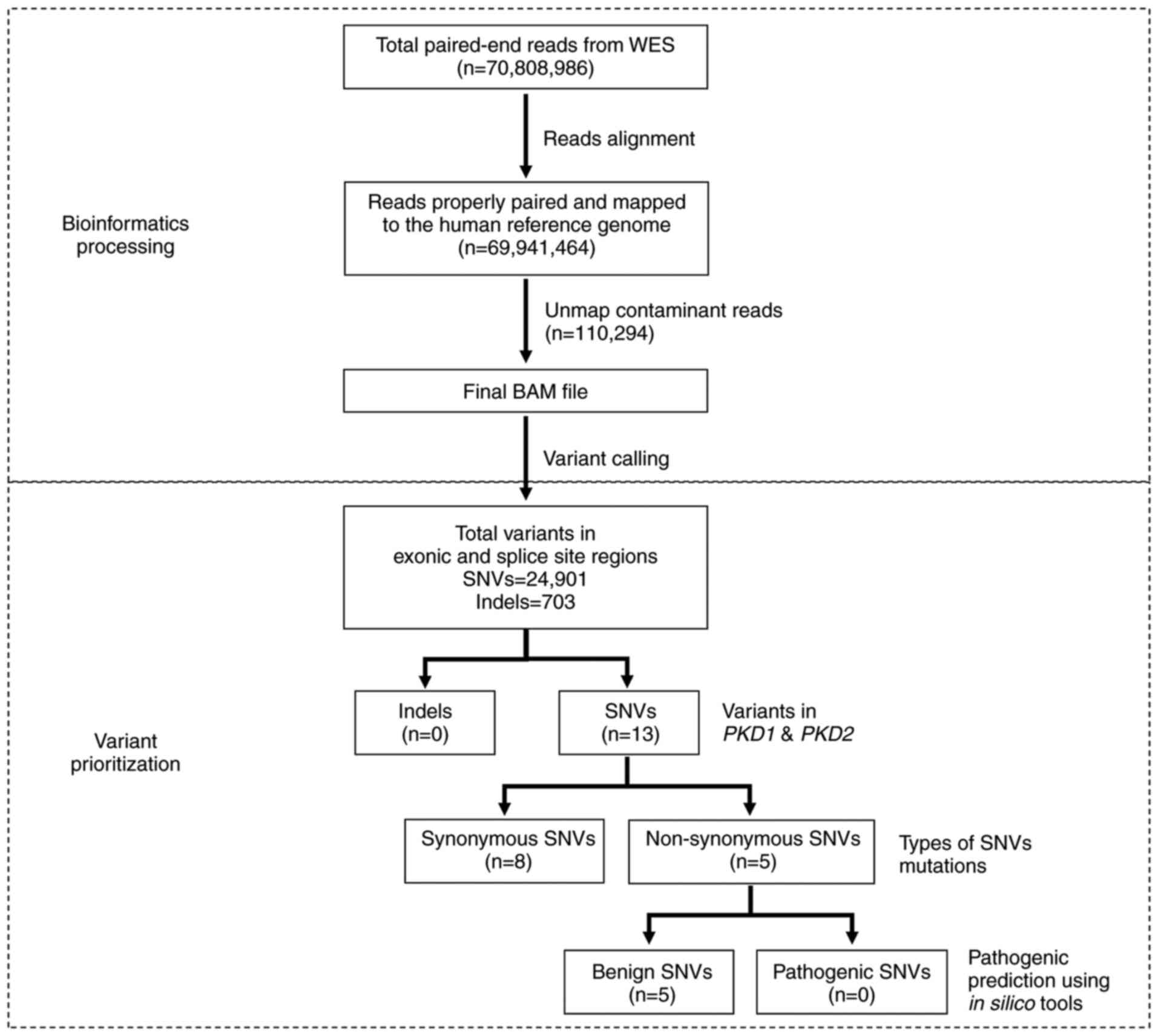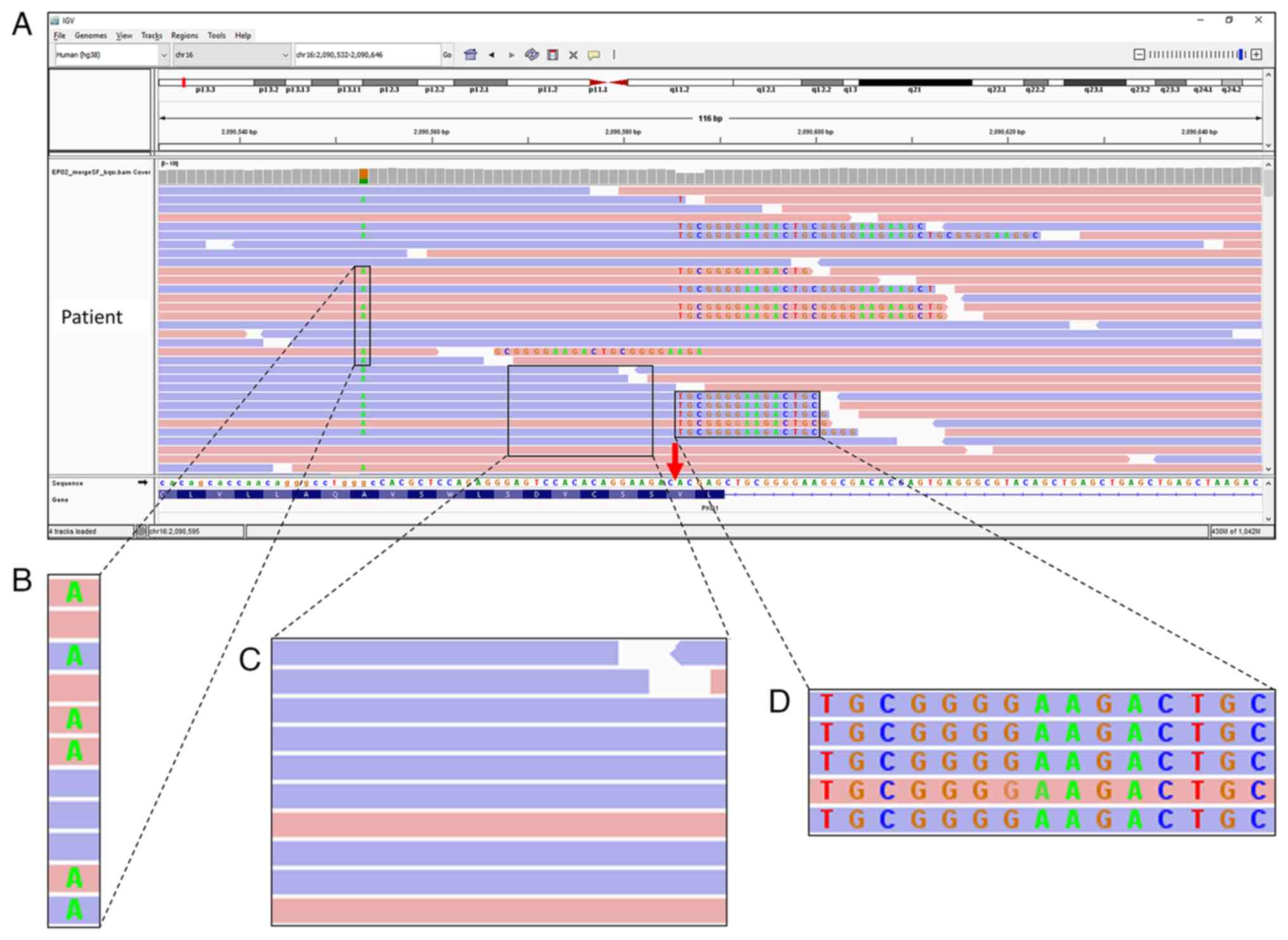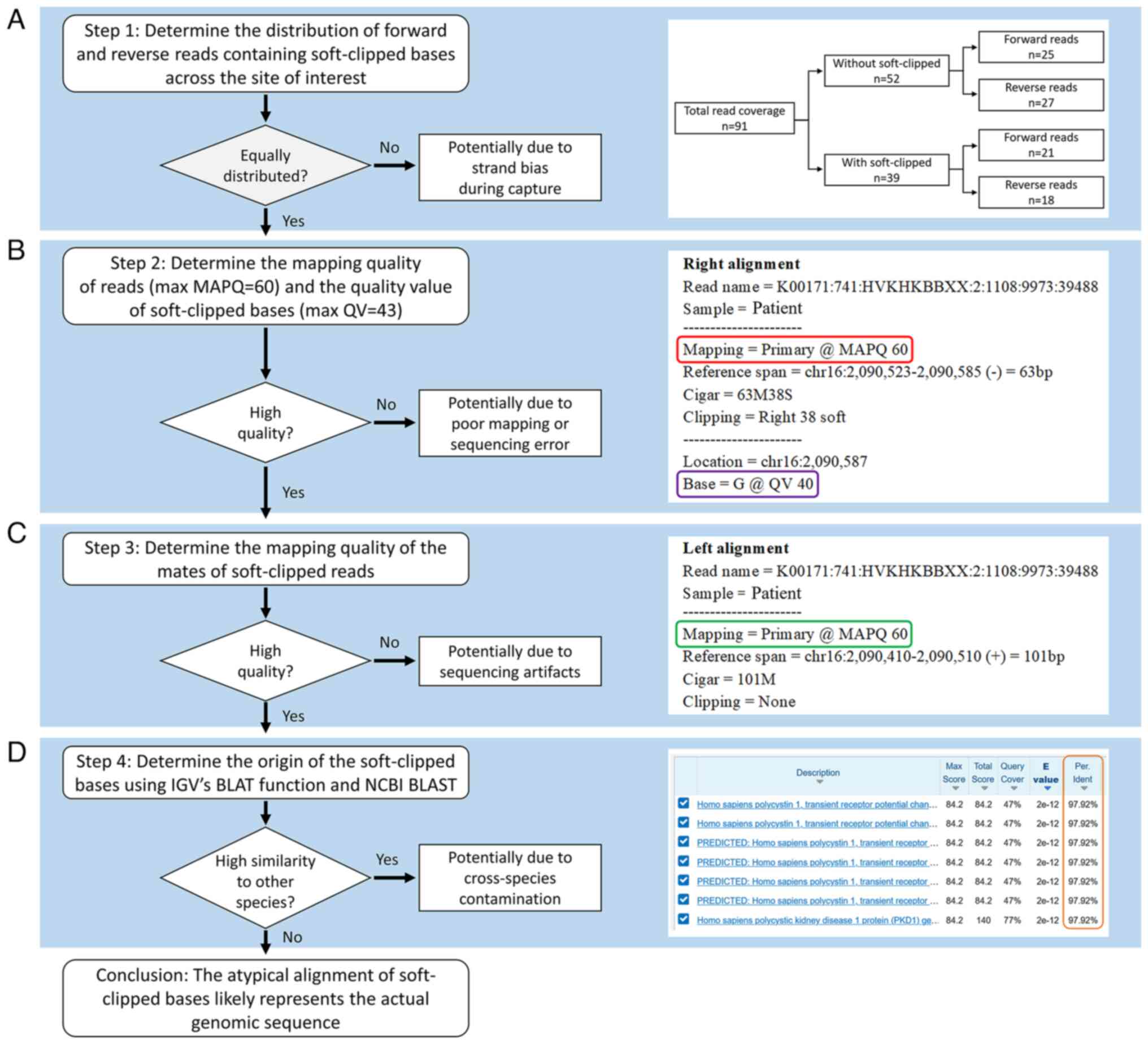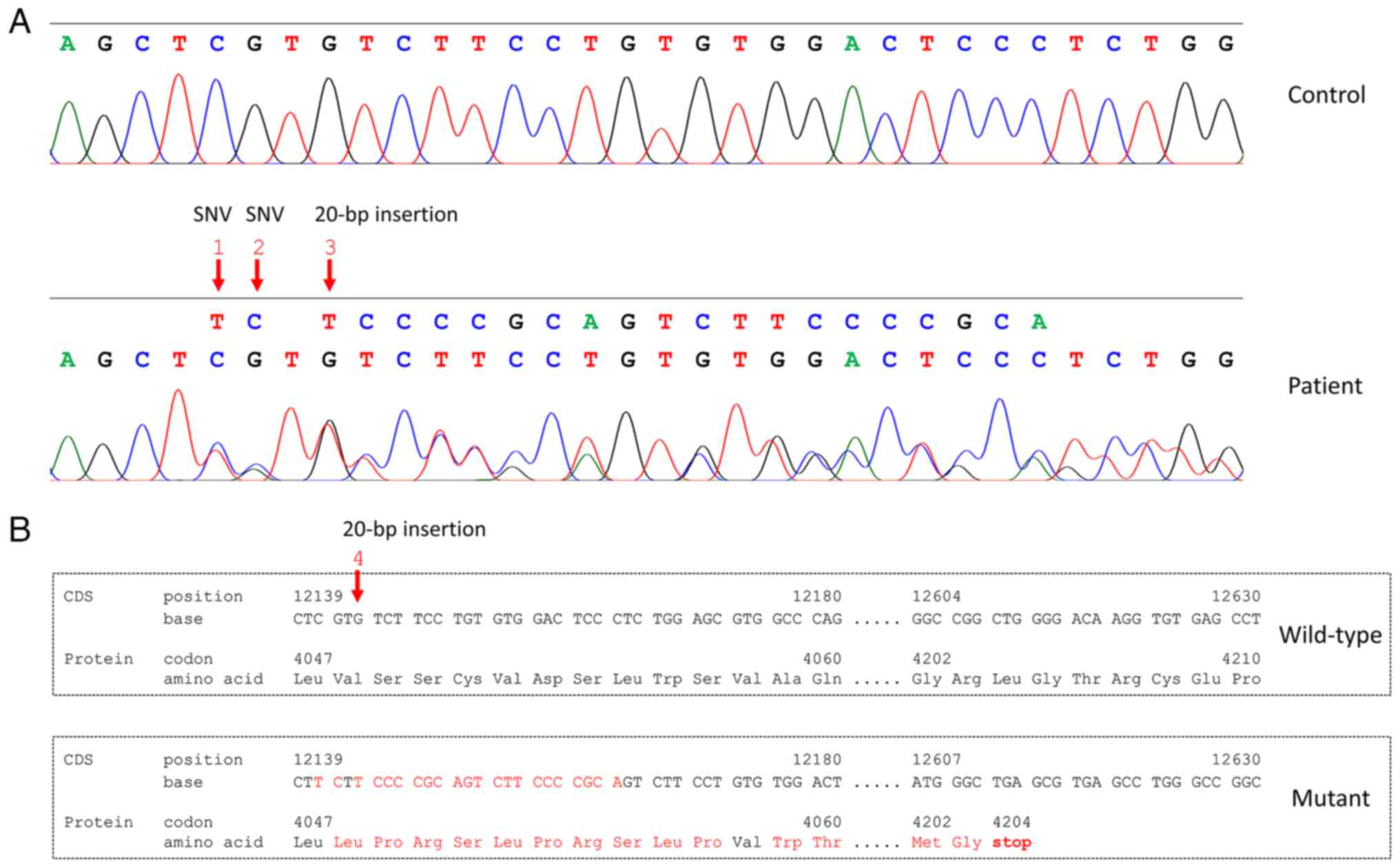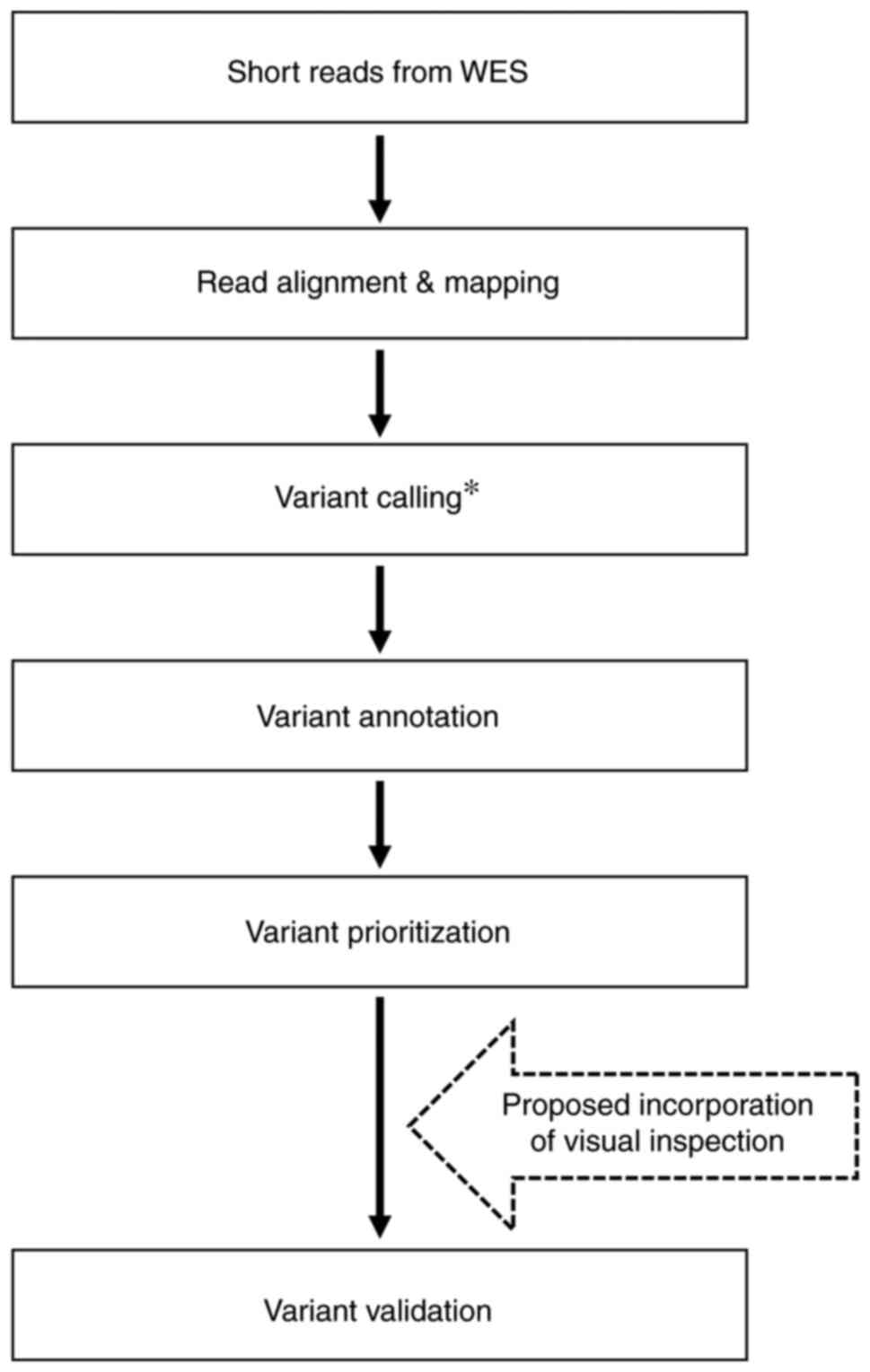|
1
|
Suwinski P, Ong C, Ling MHT, Poh YM, Khan
AM and Ong HS: Advancing personalized medicine through the
application of whole exome sequencing and big data analytics. Front
Genet. 10:492019. View Article : Google Scholar : PubMed/NCBI
|
|
2
|
Schwarze K, Buchanan J, Taylor JC and
Wordsworth S: Are whole-exome and whole-genome sequencing
approaches cost-effective? A systematic review of the literature.
Genet Med. 20:1122–1130. 2018. View Article : Google Scholar : PubMed/NCBI
|
|
3
|
Ma X, Shao Y, Tian L, Flasch DA, Mulder
HL, Edmonson MN, Liu Y, Chen X, Newman S, Nakitandwe J, et al:
Analysis of error profiles in deep next-generation sequencing data.
Genome Biol. 20:502019. View Article : Google Scholar : PubMed/NCBI
|
|
4
|
Robinson JT, Thorvaldsdottir H, Wenger AM,
Zehir A and Mesirov JP: Variant review with the integrative
genomics viewer. Cancer Res. 77:e31–e34. 2017. View Article : Google Scholar : PubMed/NCBI
|
|
5
|
Koboldt DC: Best practices for variant
calling in clinical sequencing. Genome Med. 12:912020. View Article : Google Scholar : PubMed/NCBI
|
|
6
|
Lanktree MB, Haghighi A, Guiard E, Iliuta
IA, Song X, Harris PC, Paterson AD and Pei Y: Prevalence estimates
of polycystic kidney and liver disease by population sequencing. J
Am Soc Nephrol. 29:2593–2600. 2018. View Article : Google Scholar : PubMed/NCBI
|
|
7
|
Chebib FT and Torres VE: Autosomal
dominant polycystic kidney disease: Core curriculum 2016. Am J
Kidney Dis. 67:792–810. 2016. View Article : Google Scholar : PubMed/NCBI
|
|
8
|
National Library of Medicine (US),
National Center for Biotechnology Information, . Nucleotide
NM_001009944.3. https://www.ncbi.nlm.nih.gov/nuccore/NM_001009944.3December
30–2021
|
|
9
|
National Library of Medicine (US),
National Center for Biotechnology Information, . Nucleotide
NM_000297.4. https://www.ncbi.nlm.nih.gov/nuccore/NM_000297.4December
30–2021
|
|
10
|
Bogdanova N, Markoff A, Gerke V, McCluskey
M, Horst J and Dworniczak B: Homologues to the first gene for
autosomal dominant polycystic kidney disease are pseudogenes.
Genomics. 74:333–341. 2001. View Article : Google Scholar : PubMed/NCBI
|
|
11
|
Audrézet MP, Cornec-Le Gall E, Chen JM,
Redon S, Quéré I, Creff J, Bénech C, Maestri S, Le Meur Y and Férec
C: Autosomal dominant polycystic kidney disease: Comprehensive
mutation analysis of PKD1 and PKD2 in 700 unrelated patients. Hum
Mutat. 33:1239–1250. 2012. View Article : Google Scholar : PubMed/NCBI
|
|
12
|
Yu G, Qian X, Wu Y, Li X, Chen J, Xu J and
Qi J: Analysis of gene mutations in PKD1/PKD2 by multiplex
ligation-dependent probe amplification: Some new findings. Ren
Fail. 37:366–371. 2015. View Article : Google Scholar : PubMed/NCBI
|
|
13
|
Mallawaarachchi AC, Lundie B, Hort Y,
Schonrock N, Senum SR, Gayevskiy V, Minoche AE, Hollway G, Ohnesorg
T, Hinchcliffe M, et al: Genomic diagnostics in polycystic kidney
disease: An assessment of real-world use of whole-genome
sequencing. Eur J Hum Genet. 29:760–770. 2021. View Article : Google Scholar : PubMed/NCBI
|
|
14
|
Ali H, Al-Mulla F, Hussain N, Naim M,
Asbeutah AM, AlSahow A, Abu-Farha M, Abubaker J, Al Madhoun A,
Ahmad S and Harris PC: PKD1 duplicated regions limit clinical
utility of whole exome sequencing for genetic diagnosis of
autosomal dominant polycystic kidney disease. Sci Rep. 9:41412019.
View Article : Google Scholar : PubMed/NCBI
|
|
15
|
Eisenberger T, Decker C, Hiersche M,
Hamann RC, Decker E, Neuber S, Frank V, Bolz HJ, Fehrenbach H, Pape
L, et al: An efficient and comprehensive strategy for genetic
diagnostics of polycystic kidney disease. PLoS One.
10:e01166802015. View Article : Google Scholar : PubMed/NCBI
|
|
16
|
Cordido A, Besada-Cerecedo L and
García-González MA: The genetic and cellular basis of autosomal
dominant polycystic kidney disease-a primer for clinicians. Front
Pediatr. 5:2792017. View Article : Google Scholar : PubMed/NCBI
|
|
17
|
Ripen AM, Chear CT, Baharin MF, Nallusamy
R, Chan KC, Kassim A, Choo CM, Wong KJ, Fong SM, Tan KK, et al: A
single-center pilot study in Malaysia on the clinical utility of
whole-exome sequencing for inborn errors of immunity. Clin Exp
Immunol. 206:119–128. 2021. View Article : Google Scholar : PubMed/NCBI
|
|
18
|
Ripen AM, Chiow MY, Rama Rao PR and
Mohamad SB: Revealing chronic granulomatous disease in a patient
with Williams-Beuren Syndrome using whole exome sequencing. Front
Immunol. 12:7781332021. View Article : Google Scholar : PubMed/NCBI
|
|
19
|
Van der Auwera GA, Carneiro MO, Hartl C,
Poplin R, Del Angel G, Levy-Moonshine A, Jordan T, Shakir K, Roazen
D, Thibault J, et al: From FastQ data to high confidence variant
calls: The genome analysis toolkit best practices pipeline. Curr
Protoc Bioinformatics. 43:11.10.1–11.10.33. 2013.PubMed/NCBI
|
|
20
|
Picard. Broad Institute, . GitHub
repository. http://broadinstitute.github.io/picard/February
25–2020
|
|
21
|
Li H: Aligning sequence reads, clone
sequences and assembly contigs with BWA-MEM. https://arxiv.org/abs/1303.3997February 25–2020
|
|
22
|
Poplin R, Ruano-Rubio V, DePristo MA,
Fennell TJ, Carneiro MO, Van der Auwera GA, Kling DE, Gauthier LD,
Levy-Moonshine A, Roazen D, et al: Scaling accurate genetic variant
discovery to tens of thousands of samples. bioRxiv. 201178. 2018
February 27–2020
|
|
23
|
Chang X and Wang K: wANNOVAR: annotating
genetic variants for personal genomes via the web. J Med Genet.
49:433–436. 2012. View Article : Google Scholar : PubMed/NCBI
|
|
24
|
Robinson JT, Thorvaldsdottir H, Winckler
W, Guttman M, Lander ES, Getz G and Mesirov JP: Integrative
genomics viewer. Nat Biotechnol. 29:24–26. 2011. View Article : Google Scholar : PubMed/NCBI
|
|
25
|
National Library of Medicine (US),
National Center for Biotechnology Information, . BLAST. https://blast.ncbi.nlm.nih.gov/Blast.cgiNovember
24–2021
|
|
26
|
Ng PC and Henikoff S: SIFT: Predicting
amino acid changes that affect protein function. Nucleic Acids Res.
31:3812–3814. 2003. View Article : Google Scholar : PubMed/NCBI
|
|
27
|
Schwarz JM, Cooper DN, Schuelke M and
Seelow D: MutationTaster2: Mutation prediction for the
deep-sequencing age. Nat Methods. 11:361–362. 2014. View Article : Google Scholar : PubMed/NCBI
|
|
28
|
Adzhubei IA, Schmidt S, Peshkin L,
Ramensky VE, Gerasimova A, Bork P, Kondrashov AS and Sunyaev SR: A
method and server for predicting damaging missense mutations. Nat
Methods. 7:248–249. 2010. View Article : Google Scholar : PubMed/NCBI
|
|
29
|
ADPKD Variant Database. https://pkdb.mayo.edu/28–January. 2022
|
|
30
|
Sherry ST, Ward MH, Kholodov M, Baker J,
Phan L, Smigielski EM and Sirotkin K: dbSNP: The NCBI database of
genetic variation. Nucleic Acids Res. 29:308–311. 2001. View Article : Google Scholar : PubMed/NCBI
|
|
31
|
Karczewski KJ, Francioli LC, Tiao G,
Cummings BB, Alfoldi J, Wang Q, Collins RL, Laricchia KM, Ganna A,
Birnbaum DP, et al: The mutational constraint spectrum quantified
from variation in 141,456 humans. Nature. 581:434–443. 2020.
View Article : Google Scholar : PubMed/NCBI
|
|
32
|
Richards S, Aziz N, Bale S, Bick D, Das S,
Gastier-Foster J, Grody WW, Hedge M, Lyon E, Spector E, et al:
Standards and guidelines for the interpretation of sequence
variants: A joint consensus recommendation of the American college
of medical genetics and genomics and the association for molecular
pathology. Genet Med. 17:405–424. 2015. View Article : Google Scholar : PubMed/NCBI
|
|
33
|
Gasteiger E, Gattiker A, Hoogland C,
Ivanyi I, Appel RD and Bairoch A: ExPASy: The proteomics server for
in-depth protein knowledge and analysis. Nucleic Acids Res.
31:3784–3788. 2003. View Article : Google Scholar : PubMed/NCBI
|
|
34
|
Untergasser A, Cutcutache I, Koressaar T,
Ye J, Faircloth BC, Remm M and Rozen SG: Primer3-new capabilities
and interfaces. Nucleic Acids Res. 40:e1152012. View Article : Google Scholar : PubMed/NCBI
|
|
35
|
Ye J, Coulouris G, Zaretskaya I,
Cutcutache I, Rozen S and Madden TL: Primer-BLAST: A tool to design
target-specific primers for polymerase chain reaction. BMC
Bioinformatics. 13:1342012. View Article : Google Scholar : PubMed/NCBI
|
|
36
|
Samson CA, Whitford W, Snell RG, Jacobsen
JC and Lehnert K: Contaminating DNA in human saliva alters the
detection of variants from whole genome sequencing. Sci Rep.
10:192552020. View Article : Google Scholar : PubMed/NCBI
|
|
37
|
Rossetti S, Consugar MB, Chapman AB,
Torres VE, Guay-Woodford LM, Grantham JJ, Bennett WM, Meyers CM,
Walker DL, Bae K, et al: Comprehensive molecular diagnostics in
autosomal dominant polycystic kidney disease. J Am Soc Nephrol.
18:2143–2160. 2007. View Article : Google Scholar : PubMed/NCBI
|
|
38
|
Carrera P, Calzavara S, Magistroni R, den
Dunnen JT, Rigo F, Stenirri S, Testa F, Messa P, Cerutti R, Scolari
F, et al: Deciphering variability of PKD1 and PKD2 in an Italian
cohort of 643 patients with autosomal dominant polycystic kidney
disease (ADPKD). Sci Rep. 6:308502016. View Article : Google Scholar : PubMed/NCBI
|
|
39
|
Mantovani V, Bin S, Graziano C, Capelli I,
Minardi R, Aiello V, Ambrosini E, Cristalli CP, Mattiaccio A,
Pariali M, et al: Gene panel analysis in a large cohort of patients
with autosomal dominant polycystic kidney disease allows the
identification of 80 potentially causative novel variants and the
characterization of a complex genetic architecture in a subset of
families. Front Genet. 11:4642020. View Article : Google Scholar : PubMed/NCBI
|
|
40
|
Porath B, Gainullin VG, Cornec-Le Gall E,
Dillinger EK, Heyer CM, Hopp K, Edwards ME, Madsen CD, Mauritz SR,
Banks CJ, et al: Mutations in GANAB, encoding the glucosidase IIα
subunit, cause autosomal-dominant polycystic kidney and liver
disease. Am J Hum Genet. 98:1193–1207. 2016. View Article : Google Scholar : PubMed/NCBI
|
|
41
|
Cornec-Le Gall E, Olson RJ, Besse W, Heyer
CM, Gainullin VG, Smith JM, Audrezet MP, Hopp K, Porath B, Shi B,
et al: Monoallelic mutations to DNAJB11 cause atypical
autosomal-dominant polycystic kidney disease. Am J Hum Genet.
102:832–844. 2018. View Article : Google Scholar : PubMed/NCBI
|
|
42
|
Hu HY, Zhang J, Qiu W, Liang C, Li CX, Wei
TY, Feng ZK, Guo Q, Yang K and Liu ZG: Comprehensive strategy
improves the genetic diagnosis of different polycystic kidney
diseases. J Cell Mol Med. 25:6318–6332. 2021. View Article : Google Scholar : PubMed/NCBI
|
|
43
|
Mallawaarachchi AC, Hort Y, Cowley MJ,
McCabe MJ, Minoche A, Dinger ME, Shine J and Furlong TJ:
Whole-genome sequencing overcomes pseudogene homology to diagnose
autosomal dominant polycystic kidney disease. Eur J Hum Genet.
24:1584–1590. 2016. View Article : Google Scholar : PubMed/NCBI
|
|
44
|
Al-Muhanna FA, Al-Rubaish AM, Vatte C,
Mohiuddin SS, Cyrus C, Ahmad A, Shakil Akhtar M, Albezra MA, Alali
RA, Almuhanna AF, et al: Exome sequencing of Saudi Arabian patients
with ADPKD. Ren Fail. 41:842–849. 2019. View Article : Google Scholar : PubMed/NCBI
|
|
45
|
Torres VE, Harris PC and Pirson Y:
Autosomal dominant polycystic kidney disease. Lancet.
369:1287–1301. 2007. View Article : Google Scholar : PubMed/NCBI
|
|
46
|
Khadangi F, Torkamanzehi A and Kerachian
MA: Identification of missense and synonymous variants in Iranian
patients suffering from autosomal dominant polycystic kidney
disease. BMC Nephrol. 21:4082020. View Article : Google Scholar : PubMed/NCBI
|















